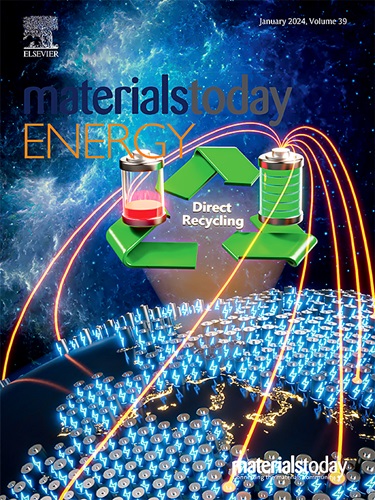利用铌氧化物提高高倍率条件下的低温锂离子电池性能
IF 8.6
2区 材料科学
Q1 CHEMISTRY, PHYSICAL
引用次数: 0
摘要
在高倍率条件下的低温运行(-20 °C及以下)是锂离子电池的一个关键缺陷。为了满足苛刻应用的尺寸、重量和功率要求,需要新型材料来维持高性能。在本研究中,我们合成了一系列铌酸盐负极材料(氧化铌、氧化铌和氧化铌),并对其粒度、缺陷性质和电导率/离子导电率进行了调整,使其能够在-20 °C的高倍率条件下(1.2C-2C)实现高性能运行。在全电池配置中与锂锰氧化物(LMO)搭配使用时,基于氧化铌的全电池可实现高倍率能力(-20 °C下2C循环速率可达90 mAh/g)和极高的长期稳定性(-20 °C下50次循环保持率大于98%)。在根据实际无人机飞行的测量数据(1.2℃-2℃的连续循环速率范围)合成的 30 分钟模拟占空比循环测试中,NbO||LMO 电池可在 -20 ℃ 下完全放电,与室温下的占空比循环相比,电压下降仅为 0.3 V。本文介绍的工作展示了未来扩展锂离子电池操作能力的可能性。本文章由计算机程序翻译,如有差异,请以英文原文为准。
Enhancing low-temperature lithium-ion battery performance under high-rate conditions with niobium oxides
Low-temperature operation (−20 °C and below) under high-rate conditions is a critical deficiency for lithium-ion batteries. To achieve size, weight, and power requirements tailored for demanding applications, novel materials are needed to sustain high performance. In the present study, we synthesize a series of niobate anode materials (NbO, NbO, and NbO) and tailor their particle size, defect nature, and electrical/ionic conductivity to enable high-performance operation at −20 °C under high-rate conditions (1.2C–2C). When paired with lithium manganese oxide (LMO) in a full-cell configuration, the NbO-based full-cells achieve high-rate capability (∼90 mAh/g up to 2C cycling rate at −20 °C) and great long-term stability (>98% retention up to 50 cycles at −20 °C). During a simulated 30 min duty cycling test synthesized from measured data from an actual drone flight (continuous range of 1.2C–2C cycling rates), the NbO||LMO cell enables full discharge at −20 °C, with only a 0.3 V voltage drop when compared to duty cycling at room temperature. The work presented herein demonstrates the future possibilities of expanding the operational capabilities of lithium-ion batteries.
求助全文
通过发布文献求助,成功后即可免费获取论文全文。
去求助
来源期刊

Materials Today Energy
Materials Science-Materials Science (miscellaneous)
CiteScore
15.10
自引率
7.50%
发文量
291
审稿时长
15 days
期刊介绍:
Materials Today Energy is a multi-disciplinary, rapid-publication journal focused on all aspects of materials for energy.
Materials Today Energy provides a forum for the discussion of high quality research that is helping define the inclusive, growing field of energy materials.
Part of the Materials Today family, Materials Today Energy offers authors rigorous peer review, rapid decisions, and high visibility. The editors welcome comprehensive articles, short communications and reviews on both theoretical and experimental work in relation to energy harvesting, conversion, storage and distribution, on topics including but not limited to:
-Solar energy conversion
-Hydrogen generation
-Photocatalysis
-Thermoelectric materials and devices
-Materials for nuclear energy applications
-Materials for Energy Storage
-Environment protection
-Sustainable and green materials
 求助内容:
求助内容: 应助结果提醒方式:
应助结果提醒方式:


